#national adoption awareness month
Explore tagged Tumblr posts
Text
Just a reminder.
1. Stop using adoptees in abortion debates.
2. Stop sharing the fact you've adopted and the child's story.
3. Adoption isn't the answer to abortion. Many kids are available for adoption and aren't adopted. We need more health care benefits not adoptions.
4. Adoptive parents shouldn't be seen as saviors. We shouldn't be made to feel grateful.
5. Stop it with the child to grow up to ne the next Lebron James, Steve Jobs, cure for cancer. All of these things require resources and a dedicated family. A child born into certain circumstances will have a harder time just getting a basic education. Also, Simone Biles shouldn't be made the face of adoption or foster care. Being adopted by your rich /parents grandparents doesn't represent all of us adoptees. It's rare in foster care. If her parents weren't rich, they wouldn't be able to afford gymnastics as, from what I was told, many foster parents aren't rich. So, using Simone as some kind of argument against abortion and for adoption is gross. Her family simply had the resources to afford such an expensive sport that has nothing to do with adoption. Plus she's with family not strangers. That's different. Plenty of kids currently in foster care many people don't care about.
6. The system is broken. Adoption doesn't mean better life. Some adoptees were abused or even rehomed aka disrupted from their adoptive homes. Many kids enter foster care and go from home to home until aging out. Some adoptees don't have good relationships with their adoptive parents. It's not a one size fits all.
7. Adoption is hard work for both sides. The adoptee and the adopted parent. It's not all sunshine and rainbows. I often feel I'm not good enough. I'm getting married soon and I have doubts of being a good wife and even if I'll be a good mom. Sometimes I don't like being adopted because it was something I didn't chose and it explains why I'm a control freak. Adoption leaves a huge hole in your heart and soul. My own birth mom didn't want me and that will never change. As I get older, it only gets harder.
#adoption#adoptee#adoptive parents#adoptive family#birth family#birthmom#adopted#national adoption awareness month#birth mom#birthmother#abortion#fostercare#fosterkids#Simonebiles
10 notes
·
View notes
Text
By: Andrew Doyle
Published: Feb 1, 2025
I do not much like the destruction of books. As a form of protest, it conjures sinister images from the past, most notably the Pathé news reels of brownshirts and students gathered around a pyre in Berlin’s Opernplatz under the watchful eye of Joseph Goebbels. The Nazis had raided libraries, universities and other private collections to harvest works by political dissidents, sexologists, “degenerate” artists and any others deemed to be “un-German”. Books by Left-wing authors such as Karl Marx, Bertolt Brecht and Rosa Luxemburg were publicly incinerated, along with fictional works by the likes of Thomas Mann, Franz Kafka, Victor Hugo, Oscar Wilde and James Joyce. This was philistinism in its purest form.
The symbolism of a burning book is, therefore, the repudiation of the very notion of freedom. And yet this same freedom means that we must be able to burn books if we so desire. The Nazis, of course, were destroying the property of others, an authoritarian act designed to eliminate whole branches of thought. This is not to be conflated with an individual who chooses to vandalise his or her own property. The trans activists who burn J.K. Rowling’s books and post the footage online are making fools of themselves, but they are also exercising their right to do so in a free society.
This is a distinction worth bearing in mind when we consider the murder of anti-Islam campaigner Salwan Momika, an Iraqi man who had been awaiting a verdict in Sweden for the crime of “agitation against an ethnic or national group”. Momika had publicly burned a number of copies of the Quran during the summer of 2023. He was shot dead during or just before a live stream on TikTok at his home in Södertälje on Wednesday. The details are as of yet unclear, but there are suggestions that the assassination may have involved a foreign power.
Momika had been granted temporary residence in Sweden in 2018, although his frustration with his adopted country’s lacklustre commitment to freedom of speech led him to seek asylum in Norway in March 2024. After just a few weeks, the Norwegian authorities had him deported back to Sweden. According to Momika, the prosecutor in his trial had been seeking his extradition back to Iraq because of his criticisms of Islam. Back in August, he had posted the following on X: “Sweden and Norway have identified me as a threat to their security. Yes, I am a threat to the Islamization project of the West, which is being pursued by your Leftist communist government that is deceiving the citizens and making the country Islamic. So I have come to awaken the people and thwart the Islamization project of the West, and I will not be afraid of you.”
In cases of this kind, it has become depressingly inevitable that commentators will seek to blame the victim. After the publication of Salman Rushdie’s novel The Satanic Verses in 1988, the Ayatollah Khomeini of Iran issued a fatwa calling for the author’s murder. Instead of taking a united stance against a foreign regime threatening the life of a British citizen, pundits and politicians engaged in endless debates about whether Rushdie had brought this on himself. Crime novelist John Le Carré stated that “there is no law in life or nature that says great religions may be insulted with impunity”, and that “there is no absolute standard of free speech in any society”. It should go without saying that powerful theocrats do not require protection from the hurtful words of novelists.
Last month was the 10th anniversary of the massacre at the offices of the French magazine Charlie Hebdo. Initially, world leaders were united in their condemnation of terrorists who had butchered cartoonists for drawing satirical caricatures of the Prophet Mohammed. Thousands gathered at vigils and held placards bearing the words “Je Suis Charlie”. PEN America — an organisation devoted to the principle of free expression — created a “courage award” for Charlie Hebdo. That was until dozens of members of PEN, including writers such as Joyce Carol Oates and Junot Díaz, signed an open letter in protest. Charlie Hebdo, they claimed, had mocked a “section of the French population that is already marginalized, embattled and victimized”. This was, of course, to misidentify the target. The cartoonists weren’t “punching down” at the Muslim minority, but rather “punching up” at the authoritarianism of institutionalised religion.
We never seem to learn that appeasement of religious extremists only makes them stronger. Our collective failure to take a firm stance for artistic liberty in the Rushdie affair has made it more difficult to uphold the principle today. That Momika was on trial in the first place suggests that Sweden’s commitment to freedom of expression has been subordinated to the creed of multiculturalism. According to the BBC, following Momika’s campaigns in 2023 the Swedish government had “pledged to explore legal means of abolishing protests that involve burning texts in certain circumstances”. Yet Momika’s copies of the Quran were his own property, and he was free to dispose of them as he wished. We might take the view that his method of protest is insensitive or provocative, but in a free society such behaviour is a matter of individual conscience.
The victim-blamers have been predictably vocal. Within hours of the news of Momika’s murder, television personality Bushra Shaikh posted the following on X: “Some of you may disagree but the public desecration of any holy book should be viewed as a hate crime and the offender should face consequences”. She later clarified that by “face consequences” she was not supporting murder, but rather the principle that the “government decides on the punishment”. And yet Shaikh’s logic defeats itself. Her post has been widely interpreted as hate-filled and authoritarian. Does this mean that, if the government were to designate the public advocacy of blasphemy laws a “hate crime”, she would be content to be prosecuted?
Those who endorse authoritarianism, in other words, are laying a trap for themselves. If we look to the state to punish our detractors, where does that leave us when the values of those in power no longer align with our own? Momika has been blamed for the riots and the international diplomatic rows that ensued following his campaigns, but the peaceful protester is not responsible for those who break the law in response. Last summer, the Guardian published a piece that presented his Quran-burning as evidence of a “racism crisis”. One of the Swedish Muslim interviewees was quoted as saying: “I understand you are allowed to think and feel what you want, this is a free country, but there must be boundaries. It’s such a pity that it has happened so many times and Sweden doesn’t seem to learn from its mistakes.”
Those of us who still believe in liberal values will baulk at the suggestion — and the implied threat — in claiming that we are mistaken to support freedom of expression. Moreover, there is nothing racist about burning a copy of the Quran. Islam is a belief-system, not a race. The criminalisation of “Islamophobia” makes about as much sense as prosecuting citizens for “Marxistophobia” or “Freemarketcapitalismophobia”. Had Momika burned a copy of The Communist Manifesto, would there be calls to modify the law to see him incarcerated?
Increasingly, Western societies are pandering to religious zealots who are willing to resort to violence to achieve their aims. Members of the ruling class are undeniably afraid. During Prime Minister’s Questions in November 2024, the Labour MP for Birmingham Hall Green and Moseley, Tahir Ali, asked Keir Starmer whether he would establish “measures to prohibit the desecration of all religious texts and the prophets of the Abrahamic religions”. Starmer replied: “I agree that desecration is awful and should be condemned across the House. We are, as I said before, committed to tackling all forms of hatred and division, including Islamophobia in all its forms.” A better response would have been: “Blasphemy laws are incompatible with the values of a free country.”
It is undeniably the case that Islamic theocracies are intolerant to dissent, but we have only ourselves to blame if we capitulate to pressure from foreign powers to undermine our commitment to secularism. Pakistan’s prime minister Imran Khan, for instance, blamed the radicalisation of Islamic terrorists on the French president Emmanuel Macron’s tolerance for the right of citizens to blaspheme against Islam. In October 2020, he tweeted: “President Macron has chosen to deliberately provoke Muslims, incl his own citizens, through encouraging the display of blasphemous cartoons targeting Islam & our Prophet PBUH.” President Recep Tayyip Erdoğan of Turkey even cited Momika’s Quran-burning in an attempt to scupper Sweden’s bid to join Nato in 2023.
But blasphemy only makes sense to the faithful. Stéphane Charbonnier (known as “Charb”), the cartoonist and editor-in-chief of Charlie Hebdo who was among the victims of the 2015 atrocity, addressed this point in an “open letter” completed just two days before his death. “God is only sacred to those who believe in him,” he wrote. “If you wish to insult or offend God, you have to be sure that he exists… In France, a religion is nothing more than a collection of texts, traditions, and customs that it is perfectly legitimate to criticize. Sticking a clown nose on Marx is no more offensive or scandalous than popping the same schnoz on Muhammad.”=
This is the spirit of secularism — the French tradition of laïcité — that other countries in the western world should emulate. The problem is not the complaints from those who seek the implementation of sharia in democratic nations, but those in power who fail to reject such demands unequivocally. The murder of Salwan Momika should be a wake-up call for the West. Continued appeasement will only guarantee further bloodshed. For all the short-term risks of defending free speech, our long-term security depends upon it.
--
==
"Why can't you just comply with our authoritarian religious codes?"
Because you want me to. Your religious codes are for you, not me.
This is literally terrorism. We are supposed to be afraid of what will happen to us if we don't submit to Islamic totalitarianism. That is reason enough to not just resist, but actively oppose and defy Islamic totalitarian demands.
#Andrew Doyle#Salwan Momika#islam#islamic violence#this is islam#quran#quran burning#islamic terrorism#blasphemy#blasphemy laws#Charlie Hebdo#religion#religion is a mental illness
8 notes
·
View notes
Text
Since it's Autism Awareness Month, here's
Why the puzzle piece is offensive to the Autistic Community
[Large text: Why the puzzle piece is offensive to the Autistic Community]
Unfortunately, the most commonly used symbols to represent autism are all puzzle related, like the ones bellow.
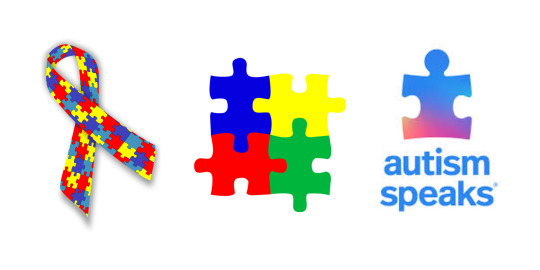
These symbols and similar ones are typically used by Autism Organizations that are run by allistic people rather than autistic, Autism Speaks being the best-known example across the internet, but not the only one.
I'm not going to go deep into how bad Autism Speaks is, but just to leave you with the tip of the iceberg, know they used to put out ads that demonized autistic people (and even one in which one of the organization's leaders spoke about wanting to drive herself and her autistic daughter off a bridge).
Autism Speaks, and many others, attempt to "teach" people about autism, without hearing what actually autistic people have to say, and that's their biggest (but not at all only) problem.
Now, stay with me as we dive into history...
The puzzle piece was first used as a symbol for autism in 1963, by UK's National Autism Society, later on being adopted by Autism Speaks, which made it more popular.
Back then, autism awareness campaigns were viewed as being similar to, for example, cancer awareness ones, because autism was seen as an illness, a disease (which it is not).
As I've made clear before, the puzzle piece is heavily associated with organizations that spread misinformation about autism, making it, of course, already a bad symbol to represent us, but there's something I personally feel bothers us a lot more, and that is the symbolism of the puzzle piece.
The puzzle piece represents an idea of "mystery" and — you guessed it — being "puzzled".
And us, autists, don't really appreciate being called confusing.
Not only that, these words were often used to describe autism offensively in the past (and still are). And, on top of that, most times, when you find a puzzle supposed to represent autism, it is incomplete.
Isn't the message clear enough?
We're people, not puzzles that have to be worked out. We're not incomplete and we're not "puzzled".
So
Which symbols can you use for autism awareness?
[Large text: Which symbols can you use for autism awareness?]
The infinity rainbow symbol is common for all neurodivergent people, while the golden infinity is specific for ASD (Autism Spectrum Disorder, in case you didn't know the acronym).

The infinity symbol represents the complexity and vastness of neurodivergence and autism.
Autism is less about "severity" and more about different struggles in different topics and areas (though not a lot of people seem to understand that, unfortunately). After all, autism is a spectrum, not a scale.
And if you're interested in why golden is the color of choice for us, that'd be because the periodic symbol for gold is Au, which I think is very clever, haha.
Some people also like to use red or plain yellow, I don't know a lot about that, but I'd recommend you research it.
And since we're on the topic of color, just a warning: in the Autistic Community we kind of avoid using blue to represent us, especially because it is heavily associated with Autism Speaks' "Light It Up Blue" movement.
Blue is seen as a representation of feelings like sadness, as well as being commonly associated with boys (this is important because women and other AFAB are often misdiagnosed and underdiagnosed because many people still think autism is only found in boys, and because many traits are viewed as "normal behavior" in AFAB people).
This isn't to say you can't use blue in the title of your PowerPoint presentation about ASD, it's just a thing we try to avoid.
Well, that should be all.
I decided to make this post because I've seen many people post about which symbols to use for Autism Awareness Month, but no one explaining why.
Thought this could help some poor lost soul understand it, lol
Happy Autism Awareness Month, my beloved Yippies, and a thank you to everyone who stopped to read <3 (heart).
Now I'm gonna go clean my search history and my gallery, just reading "Autism Speaks" gives me the ick.
#asd#autism#autism spectrum disorder#neurodivergence#neurodiversity#i'm autistic#autism awareness month#autism awareness#autism acceptence month#autism acceptance#End Autism Speaks#autistic community#on the topic of autism symbols#autism symbol#I'm autistic and I don’t need to “Light It Up”#accessibility#alt text#stop using puzzle piece autism representation#no more puzzle piece#long post
30 notes
·
View notes
Text

This month, I encourage you to create any fanworks of your choice inspired by November holidays, fun facts and even create a birthday gift to the members of the fandom born in November. You can choose the prompt you vibe the most, pair up two or more prompts, combining them with prompts from Choices fandom events and other general prompt lists.
Holidays and Events
National Adoption Month
National Native American Heritage Month
No Shave November
Transgender Awareness Month
01. All Saints' Day / World Vegan Day / National Authors Day
02. Dia de Los Muertos
03. Sandwich Day / Cliché Day
04. Book Lovers Day
05. Bonfire/Fireworks Night / Destiel day (I'm sorry but there's no way I wouldn't include this iconic Tumblr holiday 😅)
08. Cook Something Bold Day
09. World Freedom Day
10. Forget Me Not Day
11. Singles Day
12. Diwali / Chicken Soup For The Soul Day
13. Ides of November (Festival Of Jupiter) / World Kindness Day
16. World Philosophy Day
17. Take A Hike Day
18. National Princess Day
20. Black Awareness Day
22. Music/Musicians Day / Go For A Ride Day
23. Thanksgiving / National Expresso Day
24. Black Friday / Buy Nothing Day
25. International Day for the Elimination of Violence against Women
26. National Cake Day
28. French Toast Day
29. Lemon Cream Pie Day
Astronomical events
03. Jupiter at opposition - best day to see Jupiter and its moons (using a telescope)
13. Uranus at opposition - best day to see Uranus (using a telescope)
17-18. Leonids Meteor Shower (visible to the naked eye)
Facts
Birthstones: Topaz and Citrine
Flower: Chrysanthemum
Fruits: Apple, cranberry
Zodiac signs: Scorpio (until 21st) / Sagittarius (starting in Nov 22nd)
Birthday babes
04. whenyourheartskipsabeat
06. deb-1106
11. twinkle-320
16. jamespotterthefirst
17. peonyblossom
29. iaminlovewithtrr
29. katedrakeohd
30. kingliam2019
[gift suggestions]
#playchoices#play choices#choices game#choicesmonthlychallenge#choices fanfic#choices fanart#choices edits#choices moodboards#choicesnovember2023
85 notes
·
View notes
Text
by Chuck Ross
An imam linked to prominent Michigan Democrats like Gov. Gretchen Whitmer and Rep. Rashida Tlaib said in a sermon this month that pro-Israel members of Congress were "stooges" of the Jewish state who should be charged with "treason."FreeBeacon
On May 3, Hassan Qazwini, the imam of the Islamic Institute of America, railed against lawmakers who days earlier voted for the Anti-Semitism Awareness Act. The measure, which passed with a vote of 320-91, would require the Department of Education to adopt a widely accepted definition of anti-Semitism for investigations into anti-Semitic incidents on college campuses.
"If there was justice in this country, those congressmen and women would be indicted and convicted of treason," said the Iraq-born Qazwini, whose remarks were first reported by the Middle Eastern Media Research Institute. He asserted lawmakers who voted for the bill "do not work for the interest of the United States, rather for the interests of a foreign country."
"Nothing but stooges of Israel," he said.
Two months before the fiery sermon, Tlaib and Dearborn mayor Abdullah Hammoud, a rising star in the anti-Israel movement, attended a fundraiser with Qazwini for the Islamic Institute of America, based in Dearborn Heights. Qazwini honored Tlaib and Hammoud at the banquet for their "courage and outspokenness against American biases towards Israel." The trio posed for a photo at the ceremony, attended by a number of Dearborn city officials and Arab-American community leaders.
Whitmer, considered a potential Democratic presidential candidate, appeared at a fundraiser for the mosque in 2022 and was photographed with Qazwini.
Qazwini’s anti-Semitic views are nothing new, raising questions for Tlaib and Hammoud about their affiliation with the cleric. In 2020, Qazwini came under fire for his remarks several years earlier that the terrorist group ISIS "somehow is connected to Israel." In a 2016 sermon, Qazwini said that Israel has used the United States as a "cash cow" and that President Barack Obama was "bowing to the pro-Israeli lobby." He referred to Sen. Bernie Sanders (I., Vt.), who Qazwini later endorsed for president, as "an honorable man, even though he is a Jew."
Tlaib’s office and Hammoud’s office did not respond to requests for comment about their recent contact with Qazwini.
Tlaib’s affiliation with anti-Israel and pro-terrorist elements are well known. She has met with and attended fundraisers hosted by numerous Hamas supporters. Qazwini contributed $500 to her congressional campaign in 2021, according to campaign finance records. The House of Representatives censured her for circulating the statement, "From the river to the sea, Palestine will be free," a call for the eradication of Israel.
While Tlaib has been somewhat marginalized within the Democratic Party, Hammoud has emerged as a darling of the pro-Palestinian cause. In a glowing profile last month, the Washington Post praised Hammoud for leading the anti-Israel movement while balancing the duties of mayor of a medium-sized city. The Post, which said Hammoud has gone from "little-known mayor to national figure," touted Hammoud’s refusal to meet with Biden campaign officials earlier this year over opposition to President Joe Biden’s military support for Israel in its war against Hamas.
Unmentioned in the positive press coverage is Hammoud’s alliance with Dearborn-based activists who endorse Hamas’s violence. Osama Siblani, the publisher of the Arab-American News, introduced Hammoud at an event in 2022 with a speech in which Siblani called on the United States to provide Palestinians with "military aid to fight Israelis." Siblani has called Hamas and other terrorist groups "freedom fighters" and urged Islamic militants to fight Israel with "stones" and "guns."
Hours after the Hamas’s Oct. 7 invasion, in which 1,200 Israelis were murdered, Hammoud said the attack should be viewed in the "context" of Israel’s "illegal military occupation" of Gaza.
Dearborn has emerged as a hotbed of anti-Israel activity under Hammoud’s watch, with the Wall Street Journal dubbing the city "America's Jihad Capital."
Hammoud and Tlaib decried the moniker. Weeks later, attendees at a rally outside Dearborn City Hall chanted, "Death to America" and "Death to Israel."
#hassan qazwini#rashida tlaib#dearborn michigan#abdullah hammoud#osama siblani#gaza#hamas#gretchen whitmer#governor whitmer
20 notes
·
View notes
Text
So I thought it'd be silly and detract from this post to talk about fandom underneath it But I've been looking for a way to talk about this and I think this is as good a start as any.
I keep seeing a lot of people confused as to why Kazui, assuming he is a gay/aro/other closet LGBT man would want to 'decieve' Hinako by lying to her about being in romantic love with her and marrying her
It makes sense, if you're young and from the right area, you might not know a lot of history, its certainly not taught in schools. For example, to many people 'gay panic' is a cute trope, wherein a person struggles with their newly discovered identity and not a legal defence people used to excuse the beating and murder of gay people
Kazui is 39 years old. He would've turned 40 in August 2020, meaning he was born in 1980
When the comic above about Bert and Ernie getting a civil union (not even marraige yet) was made in 2003, he would've been 23.
By the time gay marraige was legalised in the US, it was 2015, Kazui would've been 35 (and despite Kazui being Japanese, because other countries like to copy America, the US legalising gay marraige was absolutely celebrated by LGBT people worldwide)


(here's a section of Our Dreams At Dusk a manga that began publication months before the legalisation of gay marraige in the US showing just two states legalising gay marraige as being news worthy to LGBT people in Japan) The first Asian country to legalise gay marraige was Taiwan in 2019 Japan is expected to be the second... but they're taking their time
Gender identity and sexual orientation are also not nationally protected civil rights, meaning protection from discrimination depends on the prefecture you live in.
And this is without getting into darker subjects like higher self harm/suicide rates or violent crimes against LGBT people
I don't want to be doom and gloom, many people are becoming more aware and accepting of LGBT people. But Kazui had every reason to wish to remain closeted
For all people talk about a 'divorce stigma' I believe it is silly to have expected a gay man in the 2000's, when many people even in the states thought gay marraige was unattainable in their lifetime, to have considered that when he got married to someone in an attempt to conform to society Especially because most difficulty to remarry after divorce comes from views surrounding custody laws and adoption. A lot of people don't want to get in a relationship with someone who already has children since they don't view them as their own on account of being blood related. This is probably why Fuuta's mother left Fuuta and his sister with their father. It's very notable that Milgram lampshades how by Kazui's age he was 'expected' to have children but didn't. We don't know Hinako's opinion on having children, but its possible Kazui intentionally didn't have any with her for this reason (despite feeling melancholy he could've had a child Muu's age by now)
Shidou had children (the eldest of which he likely sired while still being in medical school), Mahiru was still in university and thinking about planning a family, Amane notes that her mother gave birth to her when she was Mahiru's age. (TLs from Rochisama)
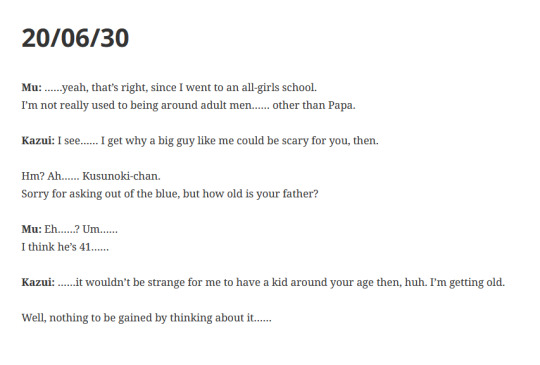


These aren't malicious feelings imo. This is Kazui noticing a coworker he likes is romantically interested in him and taking a chance on her in the hopes that playing a role as a straight man will make him into one. (unfortunately the suit doesn't fit) There is a Japanese saying of 出る杭は打たれる 'the nail that sticks out gets hammered in' suggesting it is better to not stand out (interestingly, the below lyric is the same in Japanese and English but in French its more like 'I can't take it anymore, I'm different')
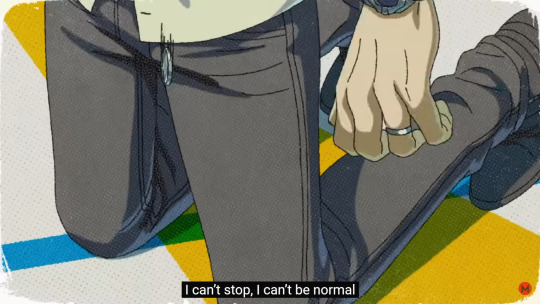
It's also worth noting that gay people getting into heterosexual relationships even outside of Japan, used to be Extremely Common. Like my mother has a co-worker who did it
In addition, Yokohama is one of the more expensive places to live in Japan. Mixed with his expensive looking wedding and the traditonal dress of the family at his wedding. It's very likely he comes from a wealthy (conservative) background which would contribute to pressures
I'm rambling a little, i'm quite tired. But I don't want people to think this means they Have to vote Kazui innocent. I don't know your theories. Maybe you think he's straight or sexuality is entirely irrelavent to his crime or you think he's gay but you just want to vote him guilty for some other reason. Any reason is allowed (although non-milgram fans trying to use him as a luck shrine has to be pretty weird)
I just think that when you judge Kazui as a gay man who 'lied' to a straight woman, you need to look at the context it happened in and the many real people who still exist in marraiges like that. Beware whomst you call deceptive or manipulative in a world were heterosexuals feel entitled to your immediate coming out.
#kazui mukuhara#milgram#ミルグラム#milgram theory#well not really but it took ages to write#you will be amazed how homophobic the 2000's and before were#stuff moved so quickly after the US legalised gay marraige
146 notes
·
View notes
Text

A look at what a BBU Tumblr dashboard might look like!
@bbu-on-the-side
CWs: BBU, pet whump, dehumanisation, everything that comes with that
🐢 turtleonhigh
As you start contemplating gifts for your loved ones, remember guys, a pet is for life, not just for Christmas! If you've never had a pet before, Domestics or Platonics are the best starter pets, but make sure to do your research thoroughly to keep your pet happy and healthy. Additionally, adopt, don't shop! There are so many pets desperately in need of loving homes. If you're insistent on purchasing from a supplier such as WRU rather than a shelter, choose refurbished. Give a pet the second chance they deserve!


🌟 thetruthinourstars
In Liberation this month: The shocking truth of WRU training away from prying eyes
🥸 bookworm420
https://www.liberation.com/20240423457899
(again. A year and a half after the first article and they're still having to expose it because no-one will listen...)
Oh come on, OP, everyone knows that's bullshit, spread by pet lib manipulators. Everyone: this is what bad actors look like!
🦀 just-a-crab
Sources?
#and before anyone leaps on me #i mean both of you #a reminder to always check where informations coming from

🍵 tea-and-pets
If prev was a pet, what would you give them as a little treat?
🐳 awhaleofatime
You guys are sick and perverted fuckers, I hope you know that
🌵 prickle
You're in the minority there mate
https://www.yougov.co.uk/topics/lifestyle/explore/HumanPets
🐳 awhaleofatime
🌞 sunshinestarlight
Stfu and let people have their fun, dude
#if you have nothing nice to say don't say anything at all #pet love #srsly dude leave us alone #polls

🐭 mouseandsammy

Sammy just adores his new outfit! Look at him go!
🌞 sunshinestarlight
❤️

🪶 fansofafeather
Ew, why am I getting WRU adverts on my dash constantly? Do I look like someone who would buy a pet to you?
🦴
Yes
🪶 fansofafeather
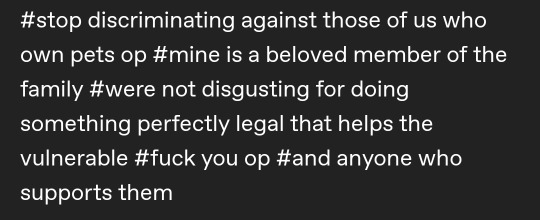
This was originally just a vent, but since you asked so nicely...
Does it help? Does it really?
Sources:
Stats show that 42% of vulnerable young people surveyed are scared of being picked up by WRU. Furthermore, spending on welfare in the UK has decreased by 26% over the past ten years, with ministers even saying that those who need help should become pets and go where they're wanted, where their "place" is. Vulnerable people need help, not encouragement to sign their lives away, and the pet industry isn't helping with that (even if you say that it isn't WRU's fault for merely existing, their adverts aren't glowing examples of a non-manipulative company).
I could go into way more detail, about the manipulation and propaganda, and what's been associated with them over the years, the politicians in their pockets holding up legislation that would hinder sign-ups, not to mention that this is actual, literal slavery, but I'll leave it here for now. If you're actually bothered you can ask, but I get the feeling you're not anyway.
How do you see your future? | YouGov

How do you feel about the alleged forced sign-ups by WRU and similar companies? | Liberation
Fact-check: Has welfare spending increased? | BBC Verify
Secretary for Work and Pensions overheard suggesting that welfare recipients "go where they're wanted" and become pets | The Guardian
WRU adverts 2000-2024 | National Archives
👯 pet-love
Callout post
Be aware. User @/sam-the-multifandom is an active member of the pet lib community, who has engaged in targeted harassment of pet owners and supporters. Evidence is in their top posts. Block and report, and spread the word to other members of the community so we can stamp out this disgusting behaviour.
👁️ eyesonthewall
Oh ffs OP. This is your evidence? Seriously? Stop lying and go back to the hole you crawled out of.
💗 nolongeracult
Proving OP's point right there. I'm former pet lib, and I can honestly say it's the most toxic community I've ever been a part of.
🍰 twopets-twocakes
Even more than the Star Wars fandom? 😝
💗 nolongeracult
YES
#pet love #their choice #petlib is toxic #love your pet #pet for life
20 notes
·
View notes
Text
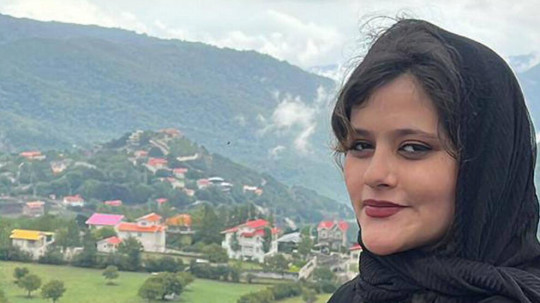
When she was a baby, she was given the nickname, “Schne”. Translated it means "a gentle breeze."
“She was a young woman who loved to sing, dance and travel,” according to writer Deutsche Welle.
But, in her country, like many countries, she didn’t have the freedom, to be herself, to even allow her hair to be caressed by a gentle breeze.
According to journalist and activist Masih Alinejad, “Schne” had told her mother:
I can’t choose what I wear . . . I don’t have the right to dance in public. By law, I’m not allowed to be myself. “‘I’m already dead,’” she said, according to journalist and activist Masih Alinejad.
She knew the dangers.
There was an ever-present fear of the police and the Guidance Patrols, widely known as "morality police," her aunt says.
“But when I go to the streets,” she said. “I have a dream. And that makes me alive.”
In 2022, Jina “Mahsa” Amini was with family visiting her brother when she was arrested for “improperly” wearing her hijab, according to Forbes. She was brought to a police station.
Her aunt says she heard what happened from one of the two cousins who avoided detention, according to Welle. She resisted being arrested, but she was still forced into the vehicle. The cousin followed the "morality police" to the police station, she says, and around two hours after the young woman’s arrest, some young women ran out of the station screaming "They killed her!"
According to writer Maggie McGrath, “after reports of the horrific incident emerged (thanks in part to reporters Niloofar Hamedi and Elahe Mohammadi, whom the Iranian regime has since jailed), protests erupted across Iran. They were led by women who tore off their hijabs, cut their hair and adopted a rallying cry of ‘women, life, freedom.’”
March 8 was International Women’s Day.
“Over 2.5 billion women and girls around the world are affected by discriminatory laws and the lack of legal protections, often in multiple ways,” according to the United Nations.
See the UN’s Infographic on Women's rights and the law in comments below.
In a speech ahead of International Women’s Day, United Nations Secretary General Antonio Guterres warned, “Decades of global progress on women’s rights are ‘vanishing before our eyes,’ arguing sexual abuse, a lack of educational and employment opportunities and the rollback of reproductive rights have pushed the goal of gender equality ‘300 years away.’”
���It's a fundamental human right for girls and women to live autonomous lives, building futures for themselves that reflect their innermost dreams and desires,” said Jessica Giusti, deputy director of communications for Girl’s Up, writing for Newsweek. “But sweeping attacks on female agency—bodily, intellectually, and otherwise—from Afghanistan, to Iran, to the United States and beyond, deny girls and women their power and capacity to thrive.”
This is a new story for the Jon S. Randal Peace Page. The Peace Page focuses on past and present stories seldom told of lives forgotten, ignored, or dismissed. The stories are gathered from writers, journalists, and historians to share awareness and foster understanding, to bring people together. And, as such, the stories this month for Women’s History Month are never relegated to one single month - they are available all year in the Peace Page archives and on this page each week throughout the year. We encourage you to learn more about the individuals and events mentioned here and to support the writers, educators, and historians whose words we present.
~~~~~
Ashkan Amini, Jina Mahsa Amini's brother, wrote on Instagram on October 11, 2022:
"We never imagined the day would come when our mother would fall asleep crying on your bed, while our father sat in the corner of the room hiding his tears from us, and that I wouldn't be able to bring myself to open the glove box of my car in case I caught sight of your hijab. ... My only wish is to embrace you one more time ..."
“For girls and women the world over, the fight for humanity and dignity is as alive as ever,” wrote Giusti.
“Girls in Afghanistan are forbidden under order of the Taliban to attend public and private universities, following an edict . . . that kept children and young women from continuing their middle school and high school educations. The strict dress code enforced by Iran's "morality police," which launched massive, ongoing protests . . . following the death of 22-year-old Jina "Mahsa" Amini, while in police custody, prevents girls and women from expressing their own individualism, religion, and cultural identities safely and authentically.”
UN Secretary General Guterres pointed to Taliban-controlled Afghanistan, where he said “women and girls have been erased from public life . . . girls have been barred from attending school past the sixth grade and women have been ordered to cover their faces in public and stay at home unless of a case of necessity.”
“In Ukraine, investigators have found widespread instances of sexual abuse by Russian forces, following the Kremlin’s invasion of the country last year, including rape and forced nudity—Russian officials have denied allegations its troops have committed human rights abuses on civilians. A U.N. report released in November found instances of Russian troops targeting girls as young as four years old and as old as 80.”
~~~~~
“Women's History Month is not just about celebrating famous figures but also about recognizing everyday heroes who make a difference in their communities,” according to writer Tricia Goss.
“On International Women’s Day, do we pay enough attention to those courageous women breaking new ground for the next generation, whether they are pointed out to us by international film crews in faraway places or whether they are right here serving others at our local nonprofits?,” wrote Susana Villegas of the San Diego Union Tribune.
“Mahsa Amini is now a global symbol for freedom, not just in Iran,” says Nina Ansary, a historian and women’s rights activist.
She was an ordinary woman to whom thousands could relate, according to Hadi Ghaemi, the founder of the Center for Human Rights in Iran. “She wasn’t an activist. Her face and her experience were very intimately and tangibly familiar to every family in Iran, because every time their mothers, sisters, and their daughters go out of the house, they have been harassed by the morality police, or detained or even beaten.”
Like Mahsa Amini, there are "anonymous mothers, daughters, grandmothers, granddaughters, sisters, aunts and childhood friends whose faces we see in the news demonstrating on the streets and in the schools of Tehran, Mexico City, Delhi, Tigray, Kabul, Abuja, Islamabad, Manila, and, yes, Washington, D.C. Namelessly, they persevere to simply exercise their rights to be who they choose to be.”
On Mahsa Amini’s tombstone is written "Dear Jina, you won't die. Your name will become a symbol."
~ jsr
The Jon S. Randal Peace Page
235 notes
·
View notes
Text
All at once now ladies "But this never happens"
By Natasha Biase March 22, 2024
Spain’s Minister of Family, Youth, and Social Affairs in Madrid is raising alarm bells after locating multiple cases in which men convicted of domestic violence changed their legal gender identity. In a letter issued to the Minister of Equality, Ana Dávila-Ponce de León Municio detailed her concerns that the safety of female victims of violence was at risk due to Spain’s “progressive” approach towards gender identity.
In her letter, issued March 18, Minister Dávila-Ponce de León noted that she had become aware of six cases in the autonomous region of Madrid where men charged with violence against women had changed their legal gender identity — a process that was streamlined and made significantly easier following the enactment of Spain’s “Trans Law” in 2023.
In addition to updating their registered sex, three of the men made requests to stay in women’s shelters with the wives and children who had been escaping from them. So far, concerned staff at the shelters have blocked their access but may be violating the nation’s gender discrimination laws as a result.

The letter sent by Minister Dávila-Ponce de León to Minister Redondo Garcia.
But perhaps most disturbingly, an abuser changing his legal sex has a tremendous impact on the resources the victims are able to access. In one of the cases recently highlighted by El Mundo, a female victim of sexual assault was stripped of the special protection provided for victims of physical and sexual abuse because officials told her that her aggressor, who drugged and raped her in front of her young daughter, “was no longer registered as a man, but as a woman.”
In Spain, special gender-based violence charges exist, providing female victims of male violence specific protections and resolutions which can impact divorce or separation proceedings, custody, and other important factors. Victims of gender-based violence can also access special protections intended to ensure they are safe from their male abuser.
Because a female cannot be convicted of gender-based violence, male abusers who change their legal sex can avoid this charge and deny their female victims of those legal protections.
As previously reported by Reduxx, a man in Spain who abused his female partner for opposing his gender transition avoided charges of gender-based violence by legally changing his identification to “female” and adopting a woman’s name. As a result, his victim was unable to obtain a specific protection order for intimate partner violence which would typically result in the male abuser being removed from the home to minimize the financial impact to the woman at a time where they are most vulnerable.

Despite only one year passing since the Trans Law was enacted by Spanish parliament, making it easier for people to “self-identify” their gender on their legal documents, several cases have emerged involving men using the law to receive financial, social, or legal benefits. The phenomenon is now being referred to as “trans fraud.”
Earlier this month, Reduxx reported that dozens of male civil servants in one small Spanish community changed their gender identity reportedly just to get benefits allocated for females. Among them was Roberto Perdigones, a 35-year-old Army corporal, who boasted of changing his legal sex to “female” after deciding he identified as an “intersex bigender” person.
From that moment on, he began to enjoy the benefits: the day he got his new ID card, he showed up at the barracks with earrings, long hair and a beard, now able to disregard mandatory dress code regulations without repercussions.
But the benefits are not limited to aesthetic issues, with Perdigones also now qualifying for a mother’s pension as he is a “woman” with a child.
“By changing my sex, as I have been informed, my pension has gone up. Because women receive more in retirement pensions to compensate for the inequality. In addition, I get 15% more because I have a child,” he boasted.
“I even have a private room in the barracks, all to myself, with a private bathroom. Because, being a woman, I can’t be with the men, and I didn’t consider it appropriate to be with the biological women out of respect for them. I’ve had the room to myself since the sex change.”

Perdigones also intends to seek a promotion and will be utilizing the so-called “affirmative action measures” designed to increase female presence in the Armed Forces command.
As Perdigones is approaching the mandatory age of retirement for temporary soldiers, obtaining a permanent position would be beneficial for him. Perdigones will be applying as a “woman,” since the physical tests are less demanding and because certain positions are seeking more female representation.
#Spain#Trans fraud#Spain's Minister of Family Youth and Social Affairs#Minister of Equality#Ana Dávila-Ponce de León Municio speaks the truth#Men abusing legal loopholes#male violence#Trans Law
17 notes
·
View notes
Text
Monthly Holidays: January
Monthly Beer Holidays
Barley Wine Month
Pub January
Tryanuary
Winter Beer Month
Monthly Food Holidays
Apple and Apricots Month
Artichoke and Asparagus Month
Be Kind to Food Servers Month
Bread Machine Baking Month
California Restaurant Month
Ginuary
National Bloody Mary Day
National Candy Month
National Egg Month
National Fiber Focus Month
National Hot Tea Month
National Meat Month
National Menudo Month
National Slow Cooking Month
National Soup Month
National Store Brands Month
National Sunday Supper Month
National Wheat Bread Month
Oatmeal Month
Prune Breakfast Month
Retail Bakers Month
Tubers and Dried Fruit Month
Veganuary
Monthly Health Holidays
California Dried Plum Digestive Health Month
Cervical Cancer ScreeningMonth
Cervical Health Awareness Month
Children Impacted by Parent’s Cancer Month
Clap 4 Health Month
Diet Month
Eye Care Month
Family Fit Lifestyle Month
Get Ireland Active Month (Ireland)
Little Things Mental Health Campaign
March of Dimes Birth Defects Prevention Month
National Bath Safety Month
National Birth Defects Prevention Month
National Blood Donor Month
National CBD Month
National Clean Up Your Computer Month
National Codependency Awareness Month
National Conscience Month
National Glaucoma Awareness Month
National Personal Self-Defense Awareness Month
National Personal Trainer Awareness Month
National Physiotherapy Month
National Pre-Pregnancy Awareness Month
National Radon Action Month
National Staying Healthy Month
National Volunteer Blood Donor Month
Receding Gums Awareness Month
Self-Help Group Awareness Month
Shape Up Month (USA)
Start Child Health Campaign (Ireland)
Teen Driving Awareness Month
Thyroid Awareness Month
Tuberous Sclerosis Awareness Month
World Health Esteem Month
Monthly Heritage Holidays
National Polka Music Month
Monthly Nature Holidays
Adopt-a-Rescued-Bird Month
National Bird-Feeding Month
National Mail Order Gardening Month
National Train Your Dog Month
Unchain a Dog Month
Walk Your Pet Month
Whale Watching Month
Other Monthly Holidays
Book Blitz Month
Cabin Fever Month
Celebration of Life Month
Chilly Month
Crime Stoppers Month
Financial Wellness Week
Get a Balanced Life Month
Get Organized Month
Human Resource Month
International Brain Teasers Month
International Change Your Stars Month
International Child-Centered Divorce Awareness Month
International Creativity Month
International Get Over It Month
International Quality of Life Month
International Wayfinding Month
Learn to Ski and Snowboard Month
Manuary
National Be On-Purpose Month
National Black Diamond Month
National Braille Literacy Month
National Creativity Month
National Hobby Month
National Mentoring Month
National Poverty in America Awareness Month
National Skating Month
National Slavery and Human Trafficking Prevention Month
National Stalking Awareness Month
National Thank You Month
Rising Star Month
Sanctity of Human Life Month
Self-Love Month
World Introvert Month
Monthly Business Holidays
Business and Reference Books Month
International New Year's Resolution Month for Business
International Wealth Mentality Month
4 notes
·
View notes
Text
False divisions and dubious equivalencies Children’s rights during the COVID-19 pandemic - Published June 18, 2024
Introduction In January 2022, nearly two years after the declaration of the COVID-19 pandemic by the World Health Organization (WHO), millions of students, educators, and parents around the world, including in the United States (US) protested that no student should have to risk their health for education (Pinsker 2022) However, many Western governments—led by Sweden, the United Kingdom (UK), and the US—have chosen to ignore calls for public health and safety. As Sweden adopted the least protective approach to community transmission, contrarian physicians in the US and UK advanced the anomalous Swedish example for in-person schooling without mitigations, particularly as soon as pediatric COVID-19 vaccines were in sight. Despite proving false for previously-vaccinated age groups, the most controversial and oft-mistaken contrarians—inexpert in social or behavioral sciences—claimed that ending school masking requirements would incentivize parents to vaccinate younger children, whose vaccine uptake never reached adequate levels despite the implementation of this advice (MSNBC 2022). Public admissions of such mistakes have never led to correcting the policies based on them. Instead, the lack of health and safety in schools resulting from zero-mitigation policies continues to cause great physical and psychosocial harms to children and families.
As a result of the COVID-19 pandemic—the worst global health crisis in over a century—at least 10.5 million children in the world have lost a parent or caregiver to COVID-19, tens of thousands of children have died, and millions have suffered disability (Bellandi 2022; UNICEF 2022). The pathway of SARS 2 infection is through the respiratory system, but COVID-19 (or COVID) is a multisystemic, vascular, and neurotropic disease with immunological effects that often renders survivors vulnerable to other infections and morbidities (Smadja et al. 2021; Temgoua et al. 2020; Zhou et al. 2020). Although the vast majority of those infected live past the initial, acute phase of infection, survivors of COVID-19 are at substantial and cumulative risk for Post-Acute Sequelae of COVID-19 (PASC), also known as Long COVID, regardless of age, vaccination, or health status (Iacurci 2022).
Life expectancy has fallen in four out of five OECD nations during the pandemic, and dramatically in the US, reversing decades-long gains (British Medical Journal 2022). Long COVID is a chronic manifestation of COVID-19 after the acute phase of infection with Severe Acute Respiratory Syndrome Coronavirus 2 (SARS-CoV-2, or SARS 2), with prolonged effects and substantial global prevalence (Chen et al. 2022). Each COVID infection carries between a one-in-five and a one-in-eight chance of progressing to Long COVID within about a month or more of infection, with recent studies reporting as high as nearly one-in-two prevalence (Centers for Disease Control and Prevention 2022d; Van Beusekom 2022). Long COVID commonly causes chronic fatigue, neurological damage, psychological disorders, memory impairment, confusion, and numerous other serious and lasting sequelae in healthy people across age groups, such as blood clots, heart attacks, and a three-fold increased risk of death within a year of a non-severe infection (Al-Aly, Bowe, and Xie 2022; Salari et al. 2022; Uusküla et al. 2022; Xu, Xie, and Al-Aly 2022). Long COVID experts admonish against current policies of mass infection, asserting the need to create awareness of this “urgent problem with a mounting human toll” (Ballering et al. 2022; Kikkenborg Berg et al. 2022; Lopez-Leon et al. 2022).
Princeton historian Keeanga-Yamahtta Taylor describes the US toll of death and disability as “surreal,” which official estimates undercount (Taylor 2022). More than one million Americans died in fewer than two-and-a-half years, exceeding four thousand deaths per day several times (Taylor 2022). More than 7 percent of the US population (twenty-three million people) suffer from disabling Long COVID, causing more than half a million Americans to become unemployed (Iacurci 2022; British Medical Journal 2022). While comprising only 4 percent of the global population, the US has the highest COVID-19 death toll in the world, has fared worse than peer countries, and has accounted for approximately one-quarter of global COVID infections and one-sixth of deaths (Bennett and Cuevas 2022; World Health Organization 2022b).
COVID-19 is the leading infectious cause of death in US children, and among the top five causes of pediatric death overall, even after vaccination (White House 2022a). US COVID mortality has exceeded four decades of AIDS mortality (Thrasher 2022, 9–10). However, in the third year of the pandemic, 4,100 COVID deaths per week—more than a weekly September 11 mass casualty event—has been treated as unremarkable by US media and politicians (Centers for Disease Control and Prevention 2022a; British Medical Journal 2022). Public health scientists, physicians, economists, and other experts representing the consensus view of the pandemic warn that “Leaders and policymakers must not accept or normalise our dangerous current status quo,” including through minimization of hazards, which lead to widespread dissemination of false beliefs (British Medical Journal 2022). Yet, leading the way, after Sweden and the UK, the US government has ended effective COVID public health mitigations, despite ongoing and escalating need for public safety measures. Other nations, such as New Zealand and Singapore, loosened otherwise stringent national safety protocols only after achieving significantly lower per-capita death rates and making considerable public health investments to secure their populations during upcoming surges (British Medical Journal 2022).
In the US and UK, poverty, gender, and race are the strongest determinants of disease burden, encompassing public-facing workers in health, service, and retail sectors (Sustainable Development Solutions 2022; Taylor 2022). Those with fewest resources carry the greatest burdens. COVID fatality rates, and therefore COVID health concerns, are consistently far higher among Black, Latinx, and other US racial minority groups (Pew Research 2021b). Counties experiencing the highest death rates are those with average poverty rates of 45 percent (Taylor 2022).
Nations that consistently implement public health measures and/or have better infrastructure for health, safety, and education see more equitable outcomes across various socio-economic metrics. The zero COVID policies of New Zealand, Australia, China, and Pacific Island nations experienced relatively rare mortality and low morbidity overall in proportion to their populations than laissez-faire nations, translating to roughly eight to ten times lower case fatality rates (Our World in Data 2020–2022; World Health Organization 2022a). Nations in which mitigations are normalized, such as the Republic of Korea and Japan, have experienced remarkably lower mortality and morbidity (Our World in Data 2020–2022). Cuba took the approach of closing in-person schools indefinitely and used the widely accessible medium of state television to broadcast national curricula during school days so that schoolchildren could continue engaging educational material from home or settings outside of school (Goodman 2021a). Cuban leadership explained that they based this decision on epidemiological and experiential understanding that viruses transmit most efficiently among children in school settings, and as a result, focused on developing a COVID vaccine for children first.
Depending on the state and timing, US pandemic response has fallen along a continuum ranging from aiming to eradicate or contain the virus (most protective) to laissez-faire (least protective), the latter of which became the dominant national approach (Bai et al. 2022; Gretchen 2020; Long et al. 2022; Normile 2021; Yang et al. 2022). Laissez-faire refers to minimal regulations in the public interest by the state, and prioritization of “free market” activity and individual “choice” (Scott and Marshall 2009, 405). Laissez-faire nations deprioritized children’s vaccination, focusing instead on protecting the elderly, who, in the US, enjoy far greater wealth, political power, and governmental spending and benefits than children (Corsaro 2015, 308–314).
Research on children’s rights during the pandemic inadequately addresses the ways children’s rights to life, health, and safety have been falsely rendered oppositional to education and child development under the guise of championing children, uncritically accepting dominant narratives underwriting laissez-faire policies (e.g., Adami and Dineen 2021). This chapter reviews scientific studies, news articles, surveys, and statistical data involving experts and policymakers, and finds that the dominant narrative of school reopenings manufactured a “debate” that created false divisions and dubious equivalencies between different sets of children’s rights. Despite scientific and international-legal consensus on children’s rights to life, health, and safety as fundamental, the protection of these rights during the pandemic was rendered adversarial to child development, psychosocial well-being, and children’s economic, educational, and social welfare rights. Dominant discourse also ignored socio-economic disparities or leveraged them in ways to promote in-person schooling without mitigations.
How and why this occurred is analyzed from an intersectional perspective, meaning that inequities and injustices resulting from harmful policies are understood as having systemic and historical roots along the lines of race, class, gender, and generational disparities, which are reproduced in and through law, politics, and policy (Crenshaw 1998). An intersectional approach shows that violations of children’s rights to life, health, and safety are occurring through the exploitation and reinforcement of longstanding structural inequities, while creating new ones. Laissez-faire policy regarding childhood education has been driven by politics and power, against scientific consensus and public opinion. Coordinated inauthentic actions, disinformation campaigns, and political violence are considered within the scope of politics and power disfiguring public policy in violation of children’s rights.
The adoption of laissez-faire pandemic policies has occurred through at least three primary means, including (1) minimization or denialism and mythologizing regarding the harms of COVID-19 to children and their network effects; (2) a moral panic of pediatric mental health and academic attrition blamed on mitigation measures; and (3) political prioritization of narrow, short-sighted economic aims that insist upon labor and schooling in unsafe spaces despite the availability of effective mitigations. A policy of no policy during a global public health emergency has created a crisis of children’s rights in which life, health, safety, and education are routinely undermined, with poorer socio-economic outcomes. This requires corrective reframing of pandemic policy to combat disinformation, normalize mitigation of communicable disease, and prioritize children’s rights, needs, and perspectives. This chapter aims to expose violations of human rights through laissez-faire pandemic policy within the larger goals of generating critical awareness of their modus operandi and prevention of further systemic harms.
#covid#mask up#pandemic#covid 19#wear a mask#coronavirus#sars cov 2#public health#still coviding#wear a respirator
6 notes
·
View notes
Text
"Professor Neil Ferguson, the architect of Britain’s lockdown, today denied ever calling for the first national stay-at-home order – in the latest instance of lockdown backpedalling."
Professor Lockdown Denies Ever Calling For Lockdown
BY TYLER DURDEN
MONDAY, NOV 06, 2023 - 03:30 AM
Authored by Will Jones via The Brownstone Institute,
In one of the more bizarre moments at the Covid Inquiry so far, Professor Neil Ferguson, the architect of Britain’s lockdown, today denied ever calling for the first national stay-at-home order – in the latest instance of lockdown backpedalling.
The Mail has more.
Professor Neil Ferguson’s terrifying March 2020 models warned that 500,000 Brits would die unless tougher action was taken to curb the virus’s spread.
It spooked Boris Johnson into adopting draconian restrictions that saw the country told they “must stay at home.” Vaccines — considered the only safe route out of the pandemic — were still months away from being deployed.
But Professor Ferguson, who quit his role as a SAGE adviser two months after being caught breaking social distancing rules to meet his married lover, today insisted he didn’t tell officials to plunge the country into a lockdown.
He told the UK COVID-19 Inquiry that the situation was “a lot more complex.”
The inquiry is in its second module, which is examining core UK decision-making and political governance.
Hugo Keith KC asked: “Do you feel that you did confine yourself to the provision of scientific advice, or did you become, despite your best endeavours, irrevocably involved in determination of policy?”
Imperial College London’s Professor Ferguson, nicknamed ‘Professor Lockdown’ for his infamous modelling, said it was a “difficult question to answer.”
He said: “I know I’m associated very much with a particular policy.
“But as you’ll be aware from the evidence I’ve given in my statement and statements of evidence, the reality was a lot more complex.
“I don’t think I stepped over that line to say ‘we need to do this now.’
“What I tried to do was at times, which was stepping outside the scientific advisory role, to try and focus people’s minds on what was going to happen and the consequences of current trends.”
The epidemiologist drew heavy flak for his team’s modelling on the Covid pandemic.
Their work suggested 500,000 Brits would die if nothing was done to stop the spread of the virus and there would be 250,000 deaths if two-thirds caught Covid.
Worth reading in full.
Ross Clark in the Spectator says that perhaps the most remarkable revelation from Professor Ferguson’s inquiry evidence is that “he spoke to and emailed Ben Warner at No. 10 on March 13th, three days before the Imperial paper [Report 9] was published.”
Warner was a data scientist brought into Downing Street by Dominic Cummings and whom Cummings later credited for inducing pandemic alarm in No. 10, so Ferguson contacting him directly beforehand is significant.
However, Clark notes that in his email to Warner,
“Ferguson then stopped short of damning the Government’s policy of mitigation rather than suppression. In fact, if the Government decided to continue with mitigation, he wrote, ‘there is a rational basis to that decision which I would say the science supports.’ However, he added, the Government should make it clear how many people were likely to die.
“Intriguingly, Ferguson then went on to write: ‘This event is in the natural disaster category and the cure (e.g. massive social distancing, shutdowns) could be worse than the disease.’ In other words, he had at least considered the possibility that lockdowns could cause more damage than they were worth – but neither he nor anyone else seems to have tried to model this.”"
29 notes
·
View notes
Text













National Sled Dog Day
High-energy, furry athletes powering through snow and ice — a testament to teamwork and nature's endurance champs.
Running through snow all day, every day, pulling a sled that can weigh hundreds if not thousands of pounds—that’s a sled dog’s job. Don’t you think they might deserve a little recognition? February 2nd is the official holiday of the sled dog that we can safely say man would not have managed very well at all without.
The History of National Sled Dog Day
Sled dogs are thought to have evolved in the mountainous regions of Northern Asia over 35,000 years ago, but are thought to have started actually pulling sleds for people about 3,000 years ago, when hunting and fishing communities were forced to move further up north to Siberia. From there, they made their way to Lapland, Alaska, Canada and even Greenland. Historical references to actual dog harnesses far outdate the first European contact with the native peoples of Alaska and Canada.
In fact, it was the Alaskan gold rush that really got the American population interested in the use of sled dogs as a form of transportation, as most gold camps were only accessible by dogsled in the winter months. In fact, for a long while, dogsleds were the only relatively dependable way of transporting anything in the harsh Alaska and Yukon weather conditions, until airplanes finally took over in the 1930s. Dogsleds were also used to patrol western Alaska as late as World War II. After that, mushing became largely recreational. One of sled dogs’ most impressive achievements was the 1925 serum run from Nome to Nenana. With a diptheria threatening the lives of people in Nome and the serum needed being 1,100 kilometers (700 miles) away in the town of Nenana, hundreds of people may have died if not for the 20 dogsled teams that worked together to relay the serum to Nome. In the end, the serum reached Nome in only 6 days, saving the lives of many. Also, the first Arctic explorers were men with sled dogs.
How to celebrate National Sled Dog Day
Sled dogs are also celebrated for their role in polar expeditions, and a number of famous dog races are organised each year. National Sled Dog Day is an opportunity to raise awareness of the animals’ dedication to the human race. It can also be a time to raise money for dog charities taking care of homeless, or sick dogs, and those that have been cruelly abandoned by their owners. There are also numerous opportunities to volunteer at your local animal shelter to spend time with some of the dogs living there, play with them, or take them out for walks.
Dogs are generally social, friendly creatures that love physical activity and playing games, so even the smallest gesture on your part to celebrate National Sled Dog Day will definitely be greatly appreciated by a dog that has nothing to do but sit in a cage or pen all day, every day.
Who knows, maybe you’ll become friends and you’ll decide to adopt the dog? That would be the ultimate gesture of respect towards the sled dogs that sacrificed their health and sometimes their lives, for the good of men.
Organizations like PETA take the opportunity to point out how many dogs are being abused and mistreated in the world and encourage people to take action if they happen to witness any kind of abuse being perpetrated on man’s best friend.
PETA is also strongly opposed to the runs that take place in Alaska every year, saying they exhaust the animals for no good reason, and implore of Alaskan tourists not to patronize the Iditarod annual commemorative race, or any tourist attractions that include dogsled rides.
Source
#Yellowknife#Northwest Territories#Whitehorse#Yukon#Balto by Frederick George Richard Roth#Stampeder Statue by Peter Lucchetti#Skagway#Central Park#New York City#USA#Canada#Seattle#Regina#RCMP Heritage Centre#Klondike Gold Rush - Seattle Unit#National Sled Dog Day#travel#original photography#vacation#tourist attraction#landmark#cityscape#architecture#NationalSledDogDay#2 February
2 notes
·
View notes
Text
"Unlike most of their brothers and sisters in eastern Canada, socialists in both Port Arthur and Fort William [now Thunder Bay] wholeheartedly embraced the creation of the OBU [One Big Union]. By October 1919, all 160 starch workers, all the bakers, and 18 general workers in Fort William united with the members of the IWW’s LWIU [Lumber Workers International Union] in Port Arthur and joined. The FOC’s [Finnish Organization of Canada] decision to declare itself a propaganda organization of the OBU created an auxiliary in Port Arthur that gained control of the Finnish Labour Temple by assuming its debt.
In the midst of the election campaign of October 1919, local newspapers reported that the OBU had established branches in the region and that an OBU-affiliated Central Labour Council (CLC) had been established in Fort William. The council adopted the structure, constitution, and bylaws of the Winnipeg council. Well attended by workers of all nationalities and by a variety of unions, the council heard predictions that the local trades and labour councils would disappear within the next few months. The newly formed executive board of the CLC reported that both the coal handlers of Fort William, who had been responsible for a number of the strikes before the First World War, and the pulp and paper mill workers were engaged in discussions that would see them joining the OBU within the next few weeks. The Brotherhood of Carpenters local, consisting of 250 members, had already gone over to the OBU. The General Workers’ Unit reported 60 new members in the last week alone.
The OBU thus appealed to a variety of strata within the working class and, in principle and up to a point in reality, transcended the region’s deep-seated ethnic divisions. Finnish workers, however, made up by far the largest ethnic group within its ranks. Well aware of this fact, and in order to discourage their further radicalization, police in both cities began a campaign of repression and harassment that, not incidentally, coincided with the 1919 election. Soon after the establishment of the first OBU branches in Port Arthur, for example, a series of raids shook that city’s “Finnish quarter” (the area immediately around the Finnish Labour Temple on Bay Street). Both local and Royal North-West Mounted Police (RNWMP) admitted to having searched, on 9 October, seven homes described as “propaganda depots,” confiscating a large amount of “Bolshevik” literature and arresting seven “Finlanders.” These arrests were followed the next day by the search and seizure of “red” material at the Fort William bookstore of Edward Ollikkala, including a large amount of IWW literature. The RNWMP was quick to point out that “of the three centers of foreign population,” the Fort William coal dock section remained quiet and those arrested were not “enemy aliens,” merely “aliens.”
The presence of the OBU at the Lakehead worried the TLC [Trades and Labour Congress of Canada] so much that it sent William Varley, an American Federation of Labor (AFL) organizer from Toronto, to the region in late October to address the local Trades and Labour Councils and the General Workers’ Unit of the OBU in Fort William. Varley devoted much of his time to demonizing the Winnipeg General Strike and the “hopelessness of this form of action.” He contended that the AFL “had done much for the workers and was the only form of organization.” Not surprisingly, his comments were met with ridicule, contempt, and often laughter. Rather than promoting a discussion about bridging the growing division among the region’s more radical unions, the ILP [Independent Labour Party], and TLC members, the meeting intensified the general hostility towards the distant labour centre. ILP alderman A.H. Dennis, for example, contended that the TLC and it alone was to blame for the division that existed both locally and nationally among workers. As he suggestively remarked, “Labour had shown by the elections in Fort William, what they could do when it got together.” The TLC, he suggested, “was out of harmony altogether with the workers,” and it no longer represented “the workers any more than the Government did the people.” The OBU, the majority present agreed, was a necessity because of the past actions of the TLC and the AFL. It appears that at this point both leftists and centrists at the Lakehead supported the OBU and identified it as the defender of regional interests against the aloof bureaucrats of the TLC. As one delegate, tired of the double-speak and manipulation demonstrated by Varley, declared: “Well, if that’s what you want, let’s hand in our charter.”"
- Michel S. Beaulieu, Labour at the Lakehead: Ethnicity, Socialism, and Politics, 1900-35. Vancouver: University of British Columbia Press, 2011. p. 70-71.
#thunder bay#fort william#port arthur#one big union#union organizing#union politics#working class politics#canadian socialism#left wing unions#police raids#finnish immigration to canada#winnipeg general strike#northwestern ontario#reading 2024#academic quote#labour at the lakehead#working class history#canadian labour revolt
3 notes
·
View notes
Text
Meet Emily Holt - AS DUSK FALLS REWRITE OC

[AS DUSK FALLS - MASTERLIST]
Do not use my character without my consent thanks <3
warning: any arts and pictures you’ll see are not mine (I found them on pinterest) and I chose instagram model (insert actor)celeb used) to portray my oc, Emily is a character 100% created by me, Justine but the style of the bio has been inspired by (insert fic universe) wiki and bios made by director Guillermo Del Toro <3
words: 2k

EMILY CHARLOTTE HOLT bio by me
INFORMATIONS
DATE OF BIRTH: around late April 1980
AGE: In May 1998, Emily is freshly 18. She’s about about a month younger than Jay.
(Tyler is 25, so born sometime in September 1973; Dale is 21, born in mid-April 1977 – Dale and Emily are exactly 3 years and 1 week apart – and Jay is 18, born in around March 1980.)
ZODIAC SIGN/MBTI TYPE: Taurus/ISFJ
(headcanons for her family members: I feel like Tyler is ESTJ, so probably a virgo, Dale is ESTP/Aries and Jay INFP/Pisces)
SEX: Female
NATIONALITY: American
ORIGINS: British (mainly)
OCCUPATION: High school Student at Bridgeley High (1994-1998, she graduated just a month before it all went down)
SKILLS: Horse riding and she was very handy, given she always wanted to work in the barn with her brothers
HOBBY: Horse riding, listening to music and hanging out with her brothers
CHARGES (if she was arrested/went to prison): Conspiracy (12 months of imprisonment); Complicit to burglary (class 3 felony) and guilty of 3rd degree burglary (3 years and 6 months of imprisonment); Complicit to hostage taking with no criminal intent, charged as Class 1 misdemeanour (6 months of imprisonment)
POSSIBLE TIME IN PRISON: minimum 5 years (if arrested, Tyler gets the death penalty if arrested, spends 14 years on death row before being executed in 2012, and if caught, Jay gets the same sentence but his death sentence is commuted to a life sentence without parole)

FAMILY
PARENTS: She’s the only daughter and youngest biological child of Sharon and Bear Holt
SIBLINGS: She has two older brothers, Tyler and Dale, and Jay, though they’re technically cousin.
RELATIVES: Brooke, her mother’s younger sister, Deceased. And unnamed paternal family members; mention of her deceased grandfather.
FRIENDS: Her best friend was the unnamed younger sister of Jessica (Dale’s crush)
EARLY LIFE: Emily was born in late April 1980, exactly 3 years and 1 week after Dale, and exactly one month after Jay, on the same day. So, when he was born and his mother, Sharon’s sister and Emily’s aunt died, and Sharon adopted him, she passed him as her daughter’s fraternal twin and raised her two oldest to consider him their sibling. While Dale and Tyler, their older brothers, grew up treating him as such, they both knew the truth, though Tyler, being older, was more aware of it. Emily was kept in the dark by her mother and learned about it way later.
Their brothers, Tyler and Dale, were respectively 7 and 3 years older than the “twins”. Both helped raising and caring for them, but essentially Tyler as most of the responsibility to care and protect his siblings fell on him as he was the eldest. Dale was very playful, and much more careless and tempestuous so Tyler also had to deal with him, on top of everything else, and was somewhat of a bully towards Jay, at some point using a BB gun on him. He teased him way more than he did Emily because when he did, Tyler would kick his ass (metaphorically speaking, or not), so he contented himself with making jokes. Sometime after Emily was born, Sharon let an almost 8-year-old Tyler hold his baby sister and it seemed to form some kind of bond already as he never forgot how she looked at him with her big eyes and smiled. He grew up to be very protective of his family but even more so of his sister, being on the contrary, quite distant and unaffectionate towards Jay, though he did care for him as well. But throughout their lives, he seemed to subtly, or not, make Jay understand that he cared more about Emily, as if he wasn't as much family.
Until she entered high school, Emily’s favourite brother was beyond the shadow of doubt, Tyler. He raised her and Jay since they were babies and kept Dale from teasing her, teaching her valuable skills, making her grow up to be someone very handy and skilful. She never realized that he felt some resentment and jealousy towards them still, but mostly towards Jay as he knew he wasn’t his biological brother and more or less subconsciously held it against him. He knew everything about his younger siblings, how they kept a squirrel as a pet when they were young, and he knew before she told anyone that she started liking grunge music when she was 11 or 12. For her 12th birthday, he got her the Nevermind album from Nirvana and a CD player, which she ended up sharing with Jay. He didn’t get such gifts for either of his brothers. She already idolized Tyler since she was a child, but he had officially become her favourite brother. At the time, and because she was too young to work, and they weren’t exactly rich, she wanted to find a way to get some money to get herself a pair of Converse, to do like Kurt Cobain so Tyler got her to help him fix things around the house and do chores and a month later, he came home with a box and gave her a pair of black converse, which she started wearing 24/7 at school.
She had a rocky relationship with her father and was quite scared of him for a while, mainly because he could get violent when drunk and hit their mother sometimes and would hit Tyler and Dale too when they got in the middle. But when she was younger, maybe 8 or so, he one day brought home some rabbit he had caught and she wouldn’t listen to him and sit down because she wanted to go play outside with Jay but also because she didn’t want to skin the animal, so he smacked her across the face, bringing her to tears and she ran off. She hid in the barn, in a corner, curled up and quietly crying, until Tyler, then 15-year-old, found her. He had a bruise on his cheek, and she cried even more and asked if he got hit because of her. He dismissed her worries and got her to come out and help him somewhere else on the property. At dinner, her father awkwardly apologised, coming up with excuses and empty words, talking a lot but basically saying nothing, and she just nodded, not really saying anything. She already didn’t trust her father, or feel safe around him, but she certainly wouldn’t after that. After that event, Dale would always crack jokes and used the fact that he was always teasing Jay to make her laugh. He very lightly teased her too but with Tyler watching her, he never went as far as he did with Jay. She was definitely Tyler’s favourite too. The first memory he had with her was her smiling at him as a baby, so he hated seeing her cry. He was as protective of his mother as he was of his sister.
When she and Jay entered High school, they quickly found out how well-known their family actually was in that school, because all four Holt kids went there and the parents too back in the day. During their first year, Tyler was already 21 and very much working and Dale was already out of school, having dropped out about a year prior, and he would come pick them up everyday when Tyler couldn’t. Jay and Emily were in the same classes, so they were always together but as the freshman year went on, she made friends with other people in some of the classes they didn’t share, though always trying to include Jay in the group, but he went back to staying alone. By the end of the first semester, she had ditched her new friends and preferred to hang out with her brother, though she had kept one good friend, another girl from the group she hung out with and one boy that she liked. The two siblings began being isolated by their classmates. They would often call Jay a “weirdo” or “loser” and she would defend him. She acted exactly like Tyler did with their mom. She almost got into a fight with a couple of other kids at the school and after telling Tyler, he basically scolded her - more out of worry for her than actual anger - and told her not to get into any fights and not act like Dale, which for some reason made her want not to listen to him.
She began to act as Jay’s protector at school and it emboldened her, she was more rebellious, and it reflected in her relationship with her dad. She started to test his limits, which was probably not the best idea as he would get mad and try to hit her, but she often managed to dodge and run away, Tyler and Dale getting hit in her place, which she felt bad for. She began to think Tyler hated her because she realized he was more distant. In the beginning of the second half og her freshman year of high school, she met again a boy who was in the friend group she had temporarily joined in her first year, but he had developed a crush for her. She reciprocated his feelings and they shared a kiss. He asked her out and one week-end, Emily lied, saying she was going for a girl's pajama party as her best friend's house when really, she was going to the arcade with her boyfriend. The next morning, Sharon told Tyler to go get his sister and when he got to Emily's friend house and she wasn't there, he asked to use the landline to call his mom and told him. Sharon told him to drive around town and come home. He came home half an hour later and she was already there, getting scolded in the kitchen because she didn't want to tell them where she was the night before. At some point, she stood up because she wanted to leave, and accidentally yelled back at her mom and her dad got angrier. He swung his arm in her direction and upon dodging him, she fell against the fridge, curled up, her arms up in front of her face, eyes widened and her whole body shaking like a leaf.
Tyler and Dale got inbetween her and their dad and got hit in her place. Later, she told Tyler where and who she was with the night prior and told him she was with a guy from school. He told her not to lie and she admitted that he was her boyfriend. Dale heard and got worked up knowing a boy "touched her" and she yelled that nobody touched her and it took Tyler shoving him to make him shut up. One day at school, Dale came to pick up his siblings and he saw Emily come out of school with a boy. When she crossed his gaze and saw him, she put a distance between her and the boy but he now knew who her boyfriend was. He walked up to them and beat him up bloody. He was arrested and because he wasn't yet 18, he was sent to juvenile detention. She wouldn't talk to Dale for months after that, and didn't speak to him during the three months he spent in juvie. The boy was transferred to another school and wouldn't talk to her anymore, telling her her brother was a "fucking psycho". By the end of their second year of high school, as they turned 16, Jay dropped out and she really was alone now. She had her best friend left and that was about it for the next two years of high school.
Then, in May 1998, the events of the game happened. She wasn’t supposed to be involved in their plans, but she refused to stay behind, and Tyler agreed to let her come along, on the condition she did exactly as he said.
[AS DUSK FALLS - MASTERLIST]
Published (09/25/2024) by Andrea
#oc#original character#as dusk falls#as dusk falls oc#as dusk falls original character#as dusk falls fanfiction#as dusk falls rewrite#as dusk falls jay#as dusk falls tyler#as dusk falls dale#as dusk falls sharon#jay holt#dale holt#tyler holt#sharon holt#fanfiction#video game fanfiction#original character bio
3 notes
·
View notes
Text
May & Mother's day
The month of May can be associated with the end of the academic year and start of summer cookouts. It is also the month of mental health awareness, Jewish heritage, and national clean air month. May is also named after one of the Greek fertility goddesses, Maia. Though early May is also known for an honorary weekend called Mother’s day.
This is an American holiday that began in the 20th century as a special service of worship at a Methodist Episcopal Church in West Virginia. However, there have been other cultural celebrations of the title “mother” and the concept of motherhood. An earlier variation of mother’s day can be traced to the Greek deity Rhea, the cult of Cybele, and the Roman festival of Hilaria. These earlier traditions and celebrations were marking revitalization and bringing forth life. The modern perception of the Americanized holiday is often considered to be too commercialized. The advent of Mother’s Day was originally known as “Mothering Sunday” as a way to give a broader definition to the world.
The first mother’s day service was held in 1907 and organized by Anna Jarvis; it would be also adopted by the United States until 1920 when greeting card companies, like Hallmark, began to produce cards for the occasion. Jarvis would then organize boycotts for Mother’s day because of its commercialization, claiming that gifts and tokens meant to honor motherly figures should be handmade. Jarvis would later be arrested for disturbing the peace with her speeches and protests in 1925.
The notion of a special day to honor motherly figures of one’s life did not fall to the wayside but rather it grew and was adapted by other cultures in modern times. However, the occasion is not always observed on the second Sunday of May. The Eastern Orthodox tradition and also the United Kingdom, celebrate Mothering Sunday as being the presentation of Jesus Christ to the temple (this is February 2nd on the Julian Calendar). Many Catholic countries have reserved the occasion as Virgin Mary Day. While other countries simply observe International Women’s day, like Russia.
There is no denying that all people deserve respect and to be honored on a special day, this is typically done on birthdays, anniversaries, and now major holidays. However, what kind of material could the James Smith Noel Collection maintain for an occasion like Mother’s day? There are various famous mothers throughout history that have been written. Though it is not the mothers of history that we are showing today. To honor the concept of mothers, mothering, and motherhood, we are showing a sermon. After all, American mother’s day was started as a special religious service. The document is 16 pages long which boasts of her son’s devotion to her because of what a devoted mother she was to her son. The eulogy would have been read aloud before the collection of people that knew Judge Story and his family. There is a brief explanation of who Judge Story’s mother was just past the title page. She was born as Mehitable Pedrick and was the second wife of the surgeon Elisha Story who participated in the Boston Tea Party. Her son, her oldest child, was Judge Joseph Story and served on the supreme court during James Madison’s administration. Metitable only outlived her eldest son by two years after his death.
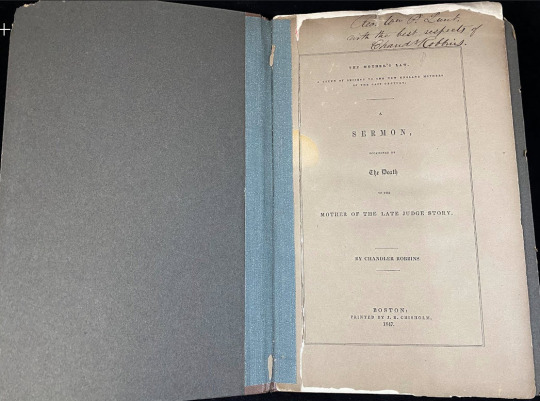
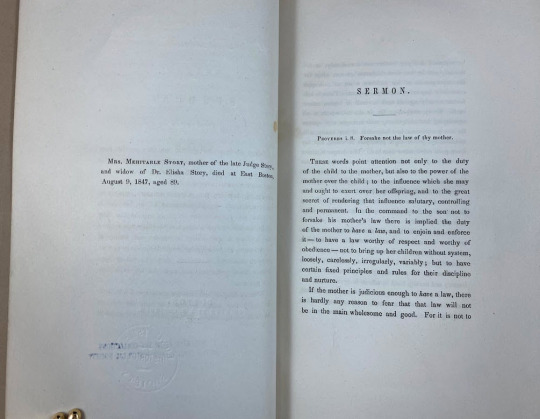
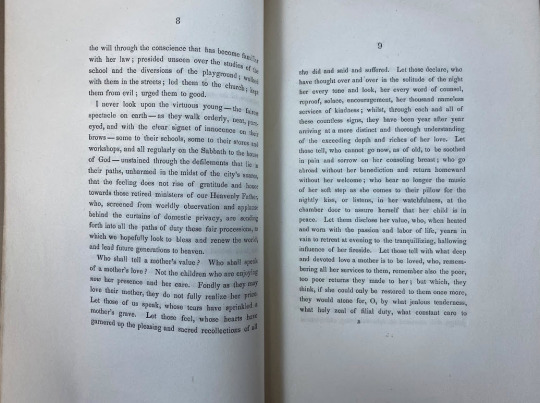
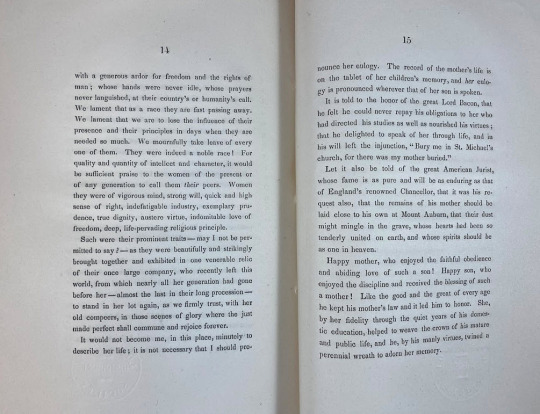
The Mother’s Law: a token of respect to the New England mothers of the last century, a sermon occasioned by the death of the mother of the late Judge Story, by Chandler Robbins was published in 1847 (https://bit.ly/3HyagLt).
20 notes
·
View notes